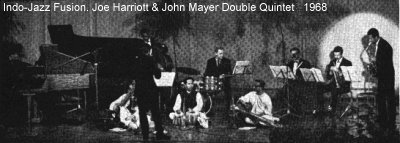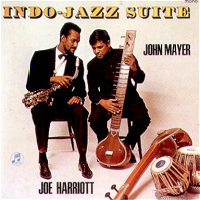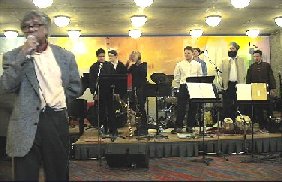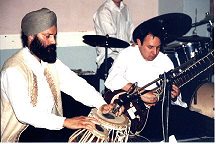[indo-jazz fusions] - [recordings] - [biography] - [reviews]
Indo-Jazz Fusions

Fusion is unique in musical conception. Eastern and western music are widely different in many respects, but in this orchestra elements to various cultures combine to perform the music of John Mayer and other composers.
Indo-Jazz was something of a first. It was certainly the first ensemble to succesfully introduce jazz, classical and Indian music to each other, and it was the first band to use the term ' fusion ' in its name. It was the first time some of the structures and sonic patterns of Indian music was used as a framework for jazz musicians to improvise on.

The first mono Indo-Jazz LP In the 1960's the Indo side of the band consisted of John Mayer on violin/harpsichord, Diwan Motihar on sitar, Chris Taylor on flute, Keshav Sathe on tabla and Chandrahas Paigankar on tambura, the Jazz side was Joe Harriott on alto, Eddie Blair on trumpet, Pat Smythe on piano, Rick Laird on bass and Alan Ganley on drums. Joe Harriott was with the band from the beginning to the end, it was following his death in 1973 that Mayer decided to close the band down. Now some twenty-five years later with a new line up the band began recording and performing again.
In these early days Mayer was working with established jazz figures who, after years of gigging around had a certain degree of inflexibilty. As Mayer puts it "...they were all hard boiled professional musicians...Joe Harriott was like a tree...I mean when the tree's grown, you can't bend with it can you? ". By contrast he feels the present day band are more inclined to try translating Indian techniques on, say, the sitar, to the keyboard, or from the tablas to the drums, and that all promotes a cohesiveness to the outfit. " There's not the isolation that there was before..there is now a closeness in the band which is so nice"
(extract of article by Robin Broadbank ©1996.)
 If you ask John Mayer why it took him so long to reform Indo-Jazz Fusions, some twenty-two years after the death of his original co-leader Joe Harriott in 1973, he pauses for a moment, and then reflects: "I felt very disheartened when Joe died, and I just didn't want to carry on with the band." Then his face brightens, as he starts to talk about the re-established group he set up in 1995, making it very clear that this is not so much a recreation of the old band, but something entirely new. "Soon after we re-formed, with the help of Air India I took the band to India, and then later with Arts Council funding we visited Bangladesh. Audiences were bowled over, and I knew then that this was different. This was a group full of new blood, playing the music a very different way. Back in the 1960's it was very much a question of having five jazz mu~cians and five Indian musicians, and we more or less alternated between the cultures. Only Pat Smythe, the original jazz pianist in the line-up, really tried to understand the ragas that underlie most of the pieces. But in the twenty years since then, a generation of musicians has grown up in Britain that actually knows about Indian music.
If you ask John Mayer why it took him so long to reform Indo-Jazz Fusions, some twenty-two years after the death of his original co-leader Joe Harriott in 1973, he pauses for a moment, and then reflects: "I felt very disheartened when Joe died, and I just didn't want to carry on with the band." Then his face brightens, as he starts to talk about the re-established group he set up in 1995, making it very clear that this is not so much a recreation of the old band, but something entirely new. "Soon after we re-formed, with the help of Air India I took the band to India, and then later with Arts Council funding we visited Bangladesh. Audiences were bowled over, and I knew then that this was different. This was a group full of new blood, playing the music a very different way. Back in the 1960's it was very much a question of having five jazz mu~cians and five Indian musicians, and we more or less alternated between the cultures. Only Pat Smythe, the original jazz pianist in the line-up, really tried to understand the ragas that underlie most of the pieces. But in the twenty years since then, a generation of musicians has grown up in Britain that actually knows about Indian music.
So what are the Indian aspects and what are the jazz aspects in the group's pieces? And what are the differences between the way indian music works and the way most jazz is structured?
Mayer is very definite about that distinction, as only someone could understand who grew up in Calcutta studying Indian music with Sanathan Mukherjee whilst simultaneously learning Western music with Melhi Mehta. "Indian music is basically built around a linear technique," he says. "There's no harmony in the Western sense, just one extended melodic line accompanied by a drone. The absence of harmony is compensated for by very complex rhythms. As I found out more about Western music, I realised that there are similarities with the techniques of serialism. In serialism you are dealing with an atonal sequence, and in ragas, the Indian scale system, you are dealing with a tonal sequence, but one which goes up one way and down another, what's called the aroha-avaroha. In most of the music we play in Indo-Jazz Fusions, the music is all scored. I don't believe in too much improvisation, and when there is space for improvising, this is done in a format which reminds the player of the notes of the raga.
Some of the music actually uses the notes of a raga, and some simply adopts ideas from one. A piece like Prayoga does both. Based on two ragas, Purva Kalyan and Yaman Kalyan, it does exactly what the Sanskrit term Frayoga suggests, with reference to the technique of expression and the manner of negotiating scales. Chhota Mitha, by contrast, is based on a raga, but an unusual one that doesn't include the fifth note of the scale what in Western music we'd call the dominant. This sets quite a different challenge for the improvising player, because they have to work within an unfamiliar scale, and even the underlying drones are different, changing the character of the sound." All this sounds very technical, and perhaps John Mayer's greatest achievement with the new band is that after three years of existence, the music now sounds entirely natural and unforced. There may be plenty of verv technical things going on in terms of structure, but the confident assimilation of ideas bv the band's musicians means that what actually comes across is the free-wheeling natural swing of Jonathan Mayer's Pisachas or the elegant classical counterpoint of the central section of Prayoga.
 John Mayer chuckles at the suggestion of counterpoint: "For the most part, what you're hearing is a stratification, layer upon layen one voice on top of anothe~ but only using the notes of the raga. What I'm doing is taking the raga and making a harmonic structure out of it, but never adding to the notes that are already there." One other reason for the chuckle is that Maver has no interest in artificial boundaries. He has been, he says, a campaigner all his life against what he calls "musical apartheid", and he can be just as critical of the purists in Indian music, who zealously protect the old guru system of aural tradition, as he is of Western musicians with closed minds and ears. His own upbringing is proof of the creative combination of two cultures, and he sees the same thing with his son Jonathan, who is already not only an accomplished sitar player but a composer.
John Mayer chuckles at the suggestion of counterpoint: "For the most part, what you're hearing is a stratification, layer upon layen one voice on top of anothe~ but only using the notes of the raga. What I'm doing is taking the raga and making a harmonic structure out of it, but never adding to the notes that are already there." One other reason for the chuckle is that Maver has no interest in artificial boundaries. He has been, he says, a campaigner all his life against what he calls "musical apartheid", and he can be just as critical of the purists in Indian music, who zealously protect the old guru system of aural tradition, as he is of Western musicians with closed minds and ears. His own upbringing is proof of the creative combination of two cultures, and he sees the same thing with his son Jonathan, who is already not only an accomplished sitar player but a composer.
Indo-Jazz Fusions is just such proof of the folly of labels. It isn't a question of the music being jazz, or Indian, or classical; it is a thoroughly satisfying blend of ingredients into something genuinely new, original and forward looking.
(Alyn Shipton ©1998.)
[indo-jazz fusions] - [recordings] - [biography] - [reviews]